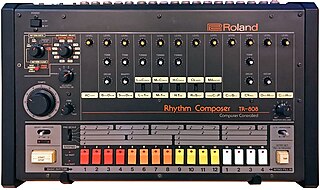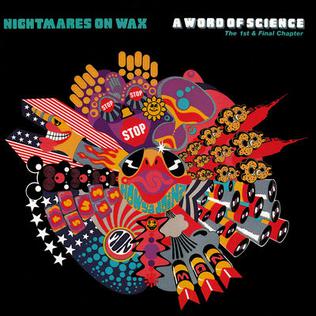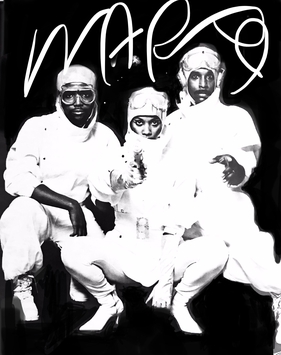Old-school hip hop is the earliest commercially recorded hip hop music and the original style of the genre. It typically refers to the music created around 1979 to 1983, as well as any hip hop that does not adhere to contemporary styles.
Breakbeat is a broad type of electronic music that tends to use drum breaks sampled from early recordings of funk, jazz, and R&B. Breakbeats have been used in styles such as Florida breaks, hip hop, jungle, drum and bass, big beat, breakbeat hardcore, and UK garage styles.

The Roland TR-808 Rhythm Composer, commonly known as the 808, is a drum machine manufactured by Roland Corporation between 1980 and 1983. It was one of the first drum machines to allow users to program rhythms instead of using preset patterns. Unlike its nearest competitor at the time, the more expensive Linn LM-1, the 808 generates sounds using analog synthesis rather than by playing samples.

Yellow Magic Orchestra was a Japanese electronic music band formed in Tokyo in 1978 by Haruomi Hosono, Yukihiro Takahashi and Ryuichi Sakamoto. The group is considered influential and innovative in the field of popular electronic music. They were pioneers in their use of synthesizers, samplers, sequencers, drum machines, computers, and digital recording technology, and effectively anticipated the "electropop boom" of the 1980s. They are credited with playing a key role in the development of several electronic genres, including synthpop, J-pop, electro, and techno, while exploring subversive sociopolitical themes throughout their career.
Miami bass is a subgenre of hip hop music that became popular in the 1980s and 1990s. The use of drums from the Roland TR-808, sustained kick drum, heavy bass, raised dance tempos, and frequently sexually explicit lyrical content differentiate it from other hip hop subgenres. Music author Richie Unterberger has characterized Miami bass as using rhythms with a "stop-start flavor" and "hissy" cymbals with lyrics that "reflected the language of the streets, particularly Miami's historically black neighborhoods such as Liberty City, Goulds, and Overtown".

Mantronix was an influential 1980s hip hop and electro funk music group from New York City. The band was formed by DJ Kurtis Mantronik and rapper MC Tee. The group is primarily remembered for its pioneering blend of old school hip hop, electronic, and club music. They underwent several genre and line-up changes during its seven-year existence between 1984 and 1991, and released five albums beginning with their 1985 debut The Album.
Tadao Kikumoto is Roland's senior managing director and head of its R&D center. He designed the TB-303 bass synthesizer and the TR-909 drum machine. He was also the chief engineer of the Roland TR-808 drum machine.
Kurtis el Khaleel, known by the stage name Kurtis Mantronik, is a Jamaican-born hip hop and electronic-music artist, DJ, remixer, and producer. He was the leader, DJ, and keyboardist of the influential 1980s hip hop and electro-funk group Mantronix. He currently lives in South Africa where he has produced and remixed house and techno music tracks by artists such as India, Junior Senior, Kylie Minogue, Fatboy Slim, The Chemical Brothers, Michael Gray, Victoria Beckham, Liberty X, S Club, and Mim. Mantronik was influential in the development of hip hop music: notably, he laid the foundations for Southern hip hop genres such as Miami bass and trap music, and helped popularize the Amen break.

Yellow Magic Orchestra is the first official studio album by Japanese electronic music band Yellow Magic Orchestra, who were previously known as the Yellow Magic Band. Originally released by Alfa Records, in Japan in 1978, the album was released by A&M Records in Europe and the United States and Canada in early 1979, with the US version featuring new cover art but without the closing track of "Acrobat". Both versions would later be re-issued in 2003 as a double-disc format, with the American version as the first disc.
Electronic dance music (EDM) is a broad range of percussive electronic music genres originally made for nightclubs, raves, and festivals. It is generally produced for playback by DJs who create seamless selections of tracks, called a DJ mix, by segueing from one recording to another. EDM producers also perform their music live in a concert or festival setting in what is sometimes called a live PA. Since its inception EDM has expanded to include a wide range of subgenres.

Hip hop production is the creation of hip hop music in a recording studio. While the term encompasses all aspects of hip hop music creation, including recording the rapping of an MC, a turntablist or DJ providing a beat, playing samples and "scratching" using record players and the creation of a rhythmic backing track, using a drum machine or sequencer, it is most commonly used to refer to recording the instrumental, non-lyrical and non-vocal aspects of hip hop.

"Planet Rock" is a song by the American hip hop artists Afrika Bambaataa and the Soul Sonic Force. The song was produced by Arthur Baker and released by Tommy Boy Records in 1982. The recording came together after DJ and producer Baker met with Bambaataa and the two bonded over the idea of creating a song about their mutual appreciation for the band Kraftwerk. Baker and Bambaataa had worked together previously on the song "Jazzy Sensation" and decided to compose a more electronic based version of the hip hop song, as opposed to the more disco-oriented work popular at the time. Along with musician John Robie, the group recorded the single at Intergalactic Studios in New York. Robie duplicated the sound on the record and had Bambaataa's rappers in the Soul Sonic Force rap over it. To create the raps, the lyricist of the group, Emcee G.L.O.B.E., had to develop a style he called "mc popping", which involved rapping off time, an unusual style at the time.

A Word of Science is the debut studio album by British electronic producers Nightmares on Wax. Released by Warp Records in September 1991, it is the act's only album as a group before it became a solo vehicle for George Evelyn. Evelyn nonetheless recorded and produced the album alone, incorporating samples and elements from demo tapes he made in the late 1980s. Although Nightmares on Wax debuted with two well-received techno singles in 1989-1990, A Word of Science is eclectic and largely moves the act towards a more mellow style influenced by funk, soul and hip hop, while still incorporating techno and house styles.
Hip-hop or hip hop music, also known as rap, and formerly as disco rap, is a genre of popular music that originated in the early 1970s by African Americans and Afro-Caribbean immigrants in the Bronx, a borough of New York City. Hip-hop music originated as an anti-drug and anti-violence genre consisting of stylized rhythmic music that often accompanies rapping, a rhythmic delivery of poetic speech. In the early 1990s, a professor of African American studies at Temple University said, "hip hop is something that blacks can unequivocally claim as their own." By the 21st century, the field of rappers had diversified by both race and gender. The music developed as part of the broader hip hop culture, a subculture defined by four key stylistic elements: MCing/rapping, DJing/scratching with turntables, breakdancing, and graffiti art. While often used to refer solely to rapping and rap music, "hip hop" more properly denotes the practice of the entire subculture. The term hip hop music is sometimes used synonymously with the term rap music, though rapping is not a required component of hip hop music; the genre may also incorporate other elements of the culture, including DJing, turntablism, scratching, beatboxing, and instrumental tracks.

Lance Taylor, also known as Afrika Bambaataa, is an American DJ, rapper, and producer from the South Bronx, New York. He is notable for releasing a series of genre-defining electro tracks in the 1980s that influenced the development of Hip Hop culture. Afrika Bambaataa is one of the originators of breakbeat DJing.
Techno is a genre of electronic dance music which is generally produced for use in a continuous DJ set, with tempos being in the range of 120 to 150 beats per minute (BPM). The central rhythm is typically in common time (4/4) and often characterized by a repetitive four on the floor beat. Artists may use electronic instruments such as drum machines, sequencers, and synthesizers, as well as digital audio workstations. Drum machines from the 1980s such as Roland's TR-808 and TR-909 are highly prized, and software emulations of such retro instruments are popular.
Boogie is a rhythm and blues genre of electronic dance music with close ties to the post-disco style, that first emerged in the United States during the late 1970s to mid-1980s. The sound of boogie is defined by bridging acoustic and electronic musical instruments with emphasis on vocals and miscellaneous effects. It later evolved into electro and house music.

Warp 9, an American sci-fi themed electro-funk, hip hop group is best known for its ground breaking, influential singles including "Nunk," "Light Years Away," and "Beat Wave," which ranked among the most iconic groups of the electro hip hop era. Described as the "perfect instance of hip hop's contemporary ramifications," Warp 9 was the brainchild of writer-producers Lotti Golden and Richard Scher. The duo wrote and recorded under the moniker Warp 9, a production project at the forefront of the electro movement.
Bleep techno is a regional subgenre of techno which developed in the late 1980s in Northern England, specifically Yorkshire. Named after its minimalistic synthesizer sounds, bleep techno combined influence from American techno and house with electro elements and heavy sub-bass inspired by reggae sound system culture. The style was commercially successful between 1989 and 1991, and became associated with artists on the Sheffield label Warp Records. It has been characterized as the first uniquely British style of electronic dance music.










